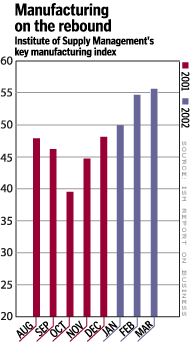
NEW YORK (CNN/Money) -
Orders for goods made in U.S. factories fell in February, the government said Tuesday, contrasting with recent signs that the long-suffering manufacturing sector is recovering from an 18-month slump.
Factory orders fell 0.1 percent in February to a seasonally adjusted $323.8 billion after a revised 1.1 percent gain in January, the Commerce Department reported. It was the first drop since November, and economists surveyed by Briefing.com expected factory orders to rise 1 percent.
"The manufacturing sector has turned the corner and improved, but it is not likely to push the economy to a level of growth that will make policy makers nervous or financial markets nervous [about higher interest rates]," said Anthony Chan, chief economist at Banc One Investment Advisors. "It's steady growth, which is better than rapid growth that would likely be snuffed out by the Federal Reserve."
U.S. stock prices continued to fall after the report, while Treasury bond prices recovered from earlier losses and rose in midday trading. Markets were largely driven by fears about oil prices, which hit six-month highs as violence in the Middle East continued and Iraq threatened an embargo.

Orders for durable goods, items such as cars and computers, that are meant to last three years or longer, rose $3.2 billion, or 1.8 percent, to $180.5 billion, the third straight month of gains. But orders for non-durable goods fell $3.4 billion, or 2.4 percent, to $143.3 billion. Shipments of all manufactured goods fell $5.8 billion, or 3.2 percent, to $178.7 billion.
The report followed Monday's announcement by the Institute of Supply Management that its closely watched index of manufacturing activity showed expansion for the second straight month in March, as the sector continued to show signs of recovery.
"A lot of people don't understand that the ISM number is not actually an output number," said Lara Rhame, economist with Brown Brothers Harriman. "It's the equivalent of consumer confidence, but for businesses. So certainly outlook has improved, but it remains to be seen how clearly that will translate into actual activity."
Manufacturing suffered the most when businesses stopped spending at the end of a boom in the late 1990s. Production slowed to a crawl, inventories backed up and more than a million jobs were cut.
A record inventory reduction at the end of 2001 set the stage for a return to production at the beginning of this year, and many economists think an inventory re-stocking could add 4 percentage points of growth to first-quarter gross domestic product (GDP).
But inventories fell again in February, according to the Commerce Department report, dropping $1.9 billion, or 0.4 percent, to $441.8 billion.
To set the stage for recovery from a recession that likely began in March 2001, the Federal Reserve cut its target for short-term interest rates 11 times in 2001. But it decided at its first two policy meetings in 2002 to leave rates alone, and Fed Chairman Alan Greenspan has declared the recession over.
| |
 Related links
Related links
| |
| | |
| | |
|
Markets anticipate the Fed will start to raise rates quickly in 2002 in order to keep inflation in check, especially if oil prices surge. But Greenspan and other economists have warned that business spending might not be as robust as consumer spending, undercutting the strength of the recovery and allowing the Fed to keep rates lower for longer.
"The Fed will raise rates, but they're aware that higher energy prices might do some of their job," Banc One's Chan said, "and inflation is not so high that they need to panic."
Adding to the picture of a sluggish recovery, two measures of retail sales at U.S. chain stores fell after a disappointing Easter season.
According to a Reuters report, the Bank of Tokyo-Mitsubishi and UBS Warburg, in their Weekly Chain Store Sales Snapshot, said chain store sales fell 0.6 percent during the week ended March 30, following a 0.6 percent drop the prior week. And Instinet's Redbook Retail Sales Average slipped 1.1 percent in the four weeks ended March 30 compared with the same period last month, according to the report.

|

